Evaluation of Decentralized, Closely-Spaced Precipitation Water and Treated Wastewater Infiltration
Abstract
1. Introduction
2. Materials and Methods
2.1. Delineation of Operational Criteria
2.2. Description of the Exemplary System and Parameter Definition for the Reference Case
2.2.1. Dimensioning of Precipitation Infiltration
2.2.2. Dimensioning of TSE Infiltration
Previous Works on TSE Infiltration Experiments
Geometric Dimensioning of the TSE Infiltration and Closely-Spaced System
2.3. Numerical Model
2.3.1. Model Set-Up
2.3.2. Evaluation of Model Scenario Sensitivity
3. Results
3.1. Simulated Variables at Selected Observation Nodes
3.2. Parameter Sensitivity Analysis
4. Discussion and Conclusions
Supplementary Materials
Author Contributions
Funding
Acknowledgments
Conflicts of Interest
References
- Newman, P. Sustainable urban water systems in rich and poor cities—Steps towards a new approach. Water Sci. Technol. 2001, 43, 93–99. [Google Scholar] [CrossRef] [PubMed]
- Daigger, G.T. Evolving Urban Water and Residuals Management Paradigms: Water Reclamation and Reuse, Decentralization, and Resource Recovery. Water Environ. Res. 2009, 81, 809–823. [Google Scholar] [CrossRef] [PubMed]
- Younos, T. Paradigm shift: Holistic approach for water management in urban environments. Front. Earth Sci. Chin. 2011, 5, 421–427. [Google Scholar] [CrossRef]
- Wang, S. Values of decentralized systems that avoid investments in idle capacity within the wastewater sector: A theoretical justification. J. Environ. Manag. 2014, 136, 68–75. [Google Scholar] [CrossRef] [PubMed]
- Ellis, J.B.; Revitt, D.M. Sewer losses and interactions with groundwater quality. Water Sci. Technol. 2002, 4, 195–202. [Google Scholar] [CrossRef]
- Lerner, D.N. Identifying and quantifying urban recharge: A review. Hydrogeol. J. 2002, 10, 143–152. [Google Scholar] [CrossRef]
- Chisala, B.N.; Lerner, D.N. Distribution of sewer exfiltration to urban groundwater. Water Manag. 2008, 161, 333–341. [Google Scholar] [CrossRef]
- Dou, T.; Troesch, S.; Petitjean, A.; Gábor, P.T.; Esser, D. Wastewater and Rainwater Management in Urban Areas: A Role for Constructed Wetlands. Procedia Environ. Sci. 2017, 37, 535–541. [Google Scholar] [CrossRef]
- United States Environmental Protection Agency (US EPA). Voluntary National Guidelines for Management of Onsite and Clustered (Decentralized) Wastewater Treatment Systems; EPA 832-B-03-001; United States Environmental Protection Agency, Office of Water: Washington, DC, USA, 2003; p. 62. Available online: https://nepis.epa.gov/Exe (accessed on 11 September 2018).
- Teerlink, J.; Hernández, V.M.; Higgins, C.P.; Drewes, J.E. Removal of trace organic chemicals in onsite wastewater soil treatment units: A laboratory experiment. Water Res. 2012, 46, 5174–5184. [Google Scholar] [CrossRef] [PubMed]
- EU91/271/EEC. Council Directive of 21 May 1991 Concerning Urban Waste Water Treatment; The Council of the European Communities: Brussels, Belgium, 1991; p. 13. Available online: https://eur-lex.europa.eu/legal-content/EN/TXT/?uri=celex%3A31991L0271 (accessed on 11 September 2018).
- Oron, G.; Campos, C.; Gillerman, L.; Salgor, M. Wastewater treatment, renovation and reuse for agricultural irrigation in small communities. Agric. Water Manag. 1999, 38, 223–234. [Google Scholar] [CrossRef]
- Bakir, H.A. Sustainable wastewater management for small communities in the Middle East and North Africa. J. Environ. Manag. 2001, 61, 319–328. [Google Scholar] [CrossRef] [PubMed]
- Chirisa, I.; Bandauko, E.; Matamanda, A.; Mandisvika, G. Decentralized domestic wastewater systems in developing countries: The case study of Harare (Zimbabwe). Appl. Water Sci. 2017, 7, 1069–1078. [Google Scholar] [CrossRef]
- Porse, E.C. Stormwater Governance and Future Cities. Water 2013, 5, 29–52. [Google Scholar] [CrossRef]
- Nickel, D.; Schoenfelder, W.; Medearis, D.; Dolowitz, D.P.; Keeley, M.; Shuster, W. German experience in managing storm water with green infrastructure. J. Environ. Plan. Manag. 2014, 5, 403–423. [Google Scholar] [CrossRef]
- Boller, M. Towards sustainable urban stormwater management. Water Sci. Technol. Water Supply 2004, 4, 55–65. [Google Scholar] [CrossRef]
- Sieker, F. On-Site stormwater management as an alternative to conventional sewer systems: A new concept spreading in Germany. Water Sci. Technol. 1998, 38, 65–71. [Google Scholar] [CrossRef]
- Bouwer, H. Artificial recharge of groundwater: Hydrogeology and engineering. Hydrogeol. J. 2002, 10, 121–142. [Google Scholar] [CrossRef]
- Shuster, W.D.; Morrison, M.A.; Thurston, H.W. Seasonal and situational impacts on the effectiveness of a decentralized stormwater management program in the reduction of runoff volume. In Proceedings of the 7th International Conference on Sustainable Techniques and Strategies for Urban Water Management/Novatech, Cincinnati, OH, USA, 28 June–1 July 2010. [Google Scholar]
- Balkema, A.J.; Preisig, H.A.; Otterpohl, R.; Lambert, F.J.D. Indicators for the sustainability assessment of wastewater treatment systems. Urban Water 2002, 4, 153–161. [Google Scholar] [CrossRef]
- Meng, F.; Fu, G.; Butler, D. Water quality permitting: From end-of-pipe to operational strategies. Water Res. 2016, 101, 114–126. [Google Scholar] [CrossRef] [PubMed]
- Massoud, M.A.; Tarhini, A.; Nasr, J.A. Decentralized approaches to wastewater treatment and management: Applicability in developing countries. J. Environ. Manag. 2009, 90, 652–659. [Google Scholar] [CrossRef] [PubMed]
- Parkinson, J.; Tayler, K. Decentralized wastewater management in peri-urban areas in low-income countries. Environ. Urban. 2003, 15, 75–90. [Google Scholar] [CrossRef]
- Zhang, D.Q.; Jinadasa, K.B.S.N.; Gersberg, R.M.; Liu, Y.; Ng, W.J.; Tan, S.K. Application of constructed wetlands for wastewater treatment in developing countries—A review of recent developments (2000–2013). J. Environ. Manag. 2014, 141, 116–131. [Google Scholar] [CrossRef] [PubMed]
- Wilderer, P.A.; Schreff, D. Decentralized and centralized wastewater management: A challenge for technology developers. Water Sci. Technol. 2000, 41, 1–8. [Google Scholar] [CrossRef]
- Jones, R.A.; Lee, G.F. Septic Tank Wastewater Disposal Systems as Phosphorus Sources for Surface Waters. J. Water Pollut. Control Fed. 1979, 51, 2764–2775. [Google Scholar]
- Aristi, I.; Von Schiller, D.; Arroita, M.; Barceló, D.; Ponsatí, L.; García-Galán, M.J.; Sabater, S.; Elogesi, A.; Acuna, V. Mixed effects of effluents from a wastewater treatment plant on river ecosystem metabolism: Subsidy or stress? Freshw. Biol. 2015, 60, 1398–1410. [Google Scholar] [CrossRef]
- Al-Musawi, T.J.; Mohammed, I.A.; Atiea, H.M. Optimum efficiency of treatment plants discharging wastewater into river, case study: Tigris river within the Baghdad city in Iraq. MethodsX 2017, 4, 445–456. [Google Scholar] [CrossRef] [PubMed]
- Jin, Z.; Zhang, X.; Li, J.; Yang, F.; Kong, D.; Wei, R.; Huang, K.; Zhou, B. Impact of wastewater treatment plant effluent on an urban river. J. Freshw. Ecol. 2017, 32, 697–710. [Google Scholar] [CrossRef]
- Li, Y.-H.; Li, H.-B.; Sun, T.-H.; Wang, X. Effects of hydraulic loading rate on pollutants removal by a deep subsurface wastewater infiltration system. Ecol. Eng. 2011, 37, 1425–1429. [Google Scholar] [CrossRef]
- Quanrud, D.M.; Arnold, R.G.; Wilson, L.G.; Conklin, M.H. Effect of soil type on water quality improvement during soil aquifer treatment. Water Sci. Technol. 1996, 33, 419–431. [Google Scholar] [CrossRef]
- Quanrud, D.M.; Hafer, J.; Karpiscak, M.M.; Zhang, J.; Lansey, K.E.; Arnold, R.G. Fate of organics during soil-aquifer treatment: Sustainability of removals in the field. Water Res. 2003, 37, 3401–3411. [Google Scholar] [CrossRef]
- Sun, T.; He, Y.; Ou, Z.; Li, P.; Chang, S.; Qi, B.; Ma, X.; Qi, E.; Zhang, H.; Ren, L.; et al. Treatment of domestic wastewater by an underground capillary seepage system. Ecol. Eng. 1998, 11, 111–119. [Google Scholar] [CrossRef]
- Viswanathan, M.N.; Al Senafy, M.N.; Rashid, T.; Al-Awadi, E.; Al-Fahad, K. Improvement of tertiary wastewater quality by soil aquifer treatment. Water Sci. Technol. 1999, 40, 159–163. [Google Scholar] [CrossRef]
- Reemtsma, T.; Gnirb, R.; Jekel, M. Infiltration of combined sewer overflow and tertiary municipal wastewater: An integrated laboratory and field study on nutrients and dissolved organics. Water Res. 2000, 34, 1179–1186. [Google Scholar] [CrossRef]
- Zhang, Z.; Lei, Z.; Zhang, Z.; Sugiura, N.; Xu, X.; Yin, D. Organics removal of combined wastewater through shallow soil infiltration treatment: A field and laboratory study. J. Hazard. Mater. 2007, 149, 657–665. [Google Scholar] [CrossRef] [PubMed]
- Van Cuyk, S.; Siegrist, R.; Logan, A.; Masson, S.; Fischer, E.; Figueroa, L. Hydraulic and purification behaviors and their interactions during wastewater treatment in soil infiltration systems. Water Res. 2001, 35, 953–964. [Google Scholar] [CrossRef]
- Oudot, J.; Ambles, A.; Bourgeois, S.; Gatellier, C.; Sebyera, N. Hydrocarbon infiltration and biodegradation in a landfarming experiment. Environ. Pollut. 1989, 59, 17–40. [Google Scholar] [CrossRef]
- DWA-A 138. Arbeitsblatt DWA-A 138 Planung, Bau und Betrieb von Anlagen zur Versickerung von Niederschlagswasser; DWA: Hennef, Germany, 2005; p. 62. ISBN 978-3-937758-66-4. [Google Scholar]
- DIN 4261-1. Small Sewage Treatment Plants—Part 1: Plants for Waste Water Pretreatment; DIN Deutsches Institut für Normung e.V.: Berlin, Germany, 2010; p. 15. [Google Scholar]
- DIN 4261-5. Small Sewage Treatment Plants—Part 5: Infiltration of Aerobic Biologically Treated Domestic Wastewater; DIN Deutsches Institut für Normung e.V.: Berlin, Germany, 2012; p. 10. [Google Scholar]
- DEKRA. Auswertung Immobilienwirtschaftlicher Daten zu Einfamilienhäusern; DEKRA: Saarbrücken, Germany, 2008; p. 41. [Google Scholar]
- KOSTRA-DWD. Software KOSTRA-DWD 2010, Version 3-1, Koordinierte Starkniederschlags-Regionalisierungs-Auswertungen; Deutscher Wetterdienst (DWD), Vertrieb Institut für technisch-wissenschaftliche Hydrologie GmbH: Nürnberg, Germany, 2010. [Google Scholar]
- Dostmann, H. (M & S Umwelttechnik GmbH, Plauen, Germany). Personal communication, 2018.
- Treskatis, C.; Hein, C.; Peiffer, S.; Hermann, F. Brunnenalterung: Sind Glaskugeln eine Alternative zum Filterkies nach DIN 4924? BBR Fachmag. Brunnen Leitungsbau 2009, 60, 36–44. [Google Scholar]
- Lyman, W.J.; Reidy, P.J.; Levy, B. Mobility and Degradation of Organic Contaminants in Subsurface Environments; CK Smoley. Inc.: Chelsea, MI, USA, 1992; p. 416. ISBN 978-0873718004. [Google Scholar]
- Meikle, A.; Amin-Hanjani, S.; Anne Glover, L.; Killham, K.; Prosser, J.I. Matric potential and the survival and activity of a Pseudomonas fluorescens inoculum in soil. Soil Biol. Biochem. 1995, 27, 881–892. [Google Scholar] [CrossRef]
- Märtner, B.; Gräber, P.-W.; Bergmann sen, M. Verbundprojekt RESS-199-016 ESEK Ganzheitliches System zur Errichtung von Kleinkläranlagen; BMBF-Funded Project: Plauen, Germany, 2013; Available online: https://forschungsinfo.tu-dresden.de/detail/forschungsprojekt/13496 (accessed on 11 September 2018).
- Fichtner, T.; Händel, F.; Engelmann, C.; Gräber, P.-W.; Blankenburg, R.; Kuke, C.; Liedl, R.; Märtner, B.; Mansel, H. Laboratory and numerical investigation of biodegradation potential during combined treated waste water and rain water infiltration to minimize of pollution risk. In Proceedings of the International Conference on New Approaches to Groundwater Vulnerability, Ustron, Poland, 4–8 June 2018. [Google Scholar]
- DIN EN 12556-3. Small Wastewater Treatment Systems for up to 50 PT—Part 3: Packaged and/or Site Assembled Domestic Wastewater Treatment Plants; German Version EN 12566-3:2016; DIN Deutsches Institut für Normung e.V.: Berlin, Germany, 2016; p. 46. [Google Scholar]
- DIN 12556-2. Small Wastewater Treatment Systems for up to 50 PT—Part 2: Soil Infiltration Systems; German Version CEN/TR 12566-2:2005; DIN Deutsches Institut für Normung e.V.: Berlin, Germany, 2007; p. 53. [Google Scholar]
- Tomoda, N. Sensibilitätsanalyse Mittels Softwaretool PCSiWaPro® von Hydrogeologischen und Hydrologischen Kenngrößen bei Versickerung von Gereinigten Abwassers aus Kleinkläranlagen. Diploma Thesis, Technische Universität Dresden, Dresden, Germany, 2012. [Google Scholar]
- Šejna, M.; Šimůnek, J.; van Genuchten, M.T. The HYDRUS Software Package for Simulating the Two- and Three-Dimensional Movement of Water, Heat, and Multiple Solutes in Variably-Saturated Porous Media; User Manual Version 2.04; PC-Progress: Riverside, CA, USA; Rio de Janeiro, Brazil; Prague, Czech Republic, 2014; p. 305. Available online: https://www.pc-progress.com/en/Default.aspx?h3d-downloads (accessed on 11 September 2018).
- Šimůnek, J.; van Genuchten, M.T.; Šejna, M. The HYDRUS Software Package for Simulating the Two- and Three-Dimensional Movement of Water, Heat, and Multiple Solutes in Variably-Saturated Porous Media; Technical Manual 2.0; PC-Progress: Riverside, CA, USA; Rio de Janeiro, Brazil; Prague, Czech Republic, 2012; p. 258. Available online: https://www.pc-progress.com/en/Default.aspx?h3d-downloads (accessed on 11 September 2018).
- Richards, L.A. Capillary conduction of liquids through porous mediums. J. Appl. Phys. 1931, 1, 318–333. [Google Scholar] [CrossRef]
- Van Genuchten, M.T. A closed-form equation for predicting the hydraulic conductivity of unsaturated soils. Soil Sci. Soc. Am. J. 1980, 44, 892–898. [Google Scholar] [CrossRef]
- Mualem, Y. A new model for predicting the hydraulic conductivity of unsaturated porous media. Water Resour. Res. 1976, 12, 513–522. [Google Scholar] [CrossRef]
- Gräber, P.-W.; Blankenburg, R.; Kemmesies, O.; Krug, S. SiWaProDSS –Beratungssystem zur Simulation von Prozessen der unterirdischen Zonen. In Simulation in Umwelt-und Geowissenschaften—Workshop Leipzig 2006; Wittmann, J., Müller, M., Eds.; Shaker: Leipzig, Germany, 2006; p. 278. ISBN 978-3-8322-5132-1. [Google Scholar]
- Breiman, L. Random Forests. Mach. Learn. 2001, 45, 5–32. [Google Scholar] [CrossRef]
- Parkhurst, D.L.; Appelo, C.A.J. User’s Guide to PHREEQC (Version 2)—A Computer Program for Speciation, Batch-Reaction, One-Dimensional Transport, and Inverse Geochemical Calculation; Water-Resources Investigations Report 99-4259; U.S. Geological Survey: Denver, CO, USA, 2006; p. 312. [CrossRef]

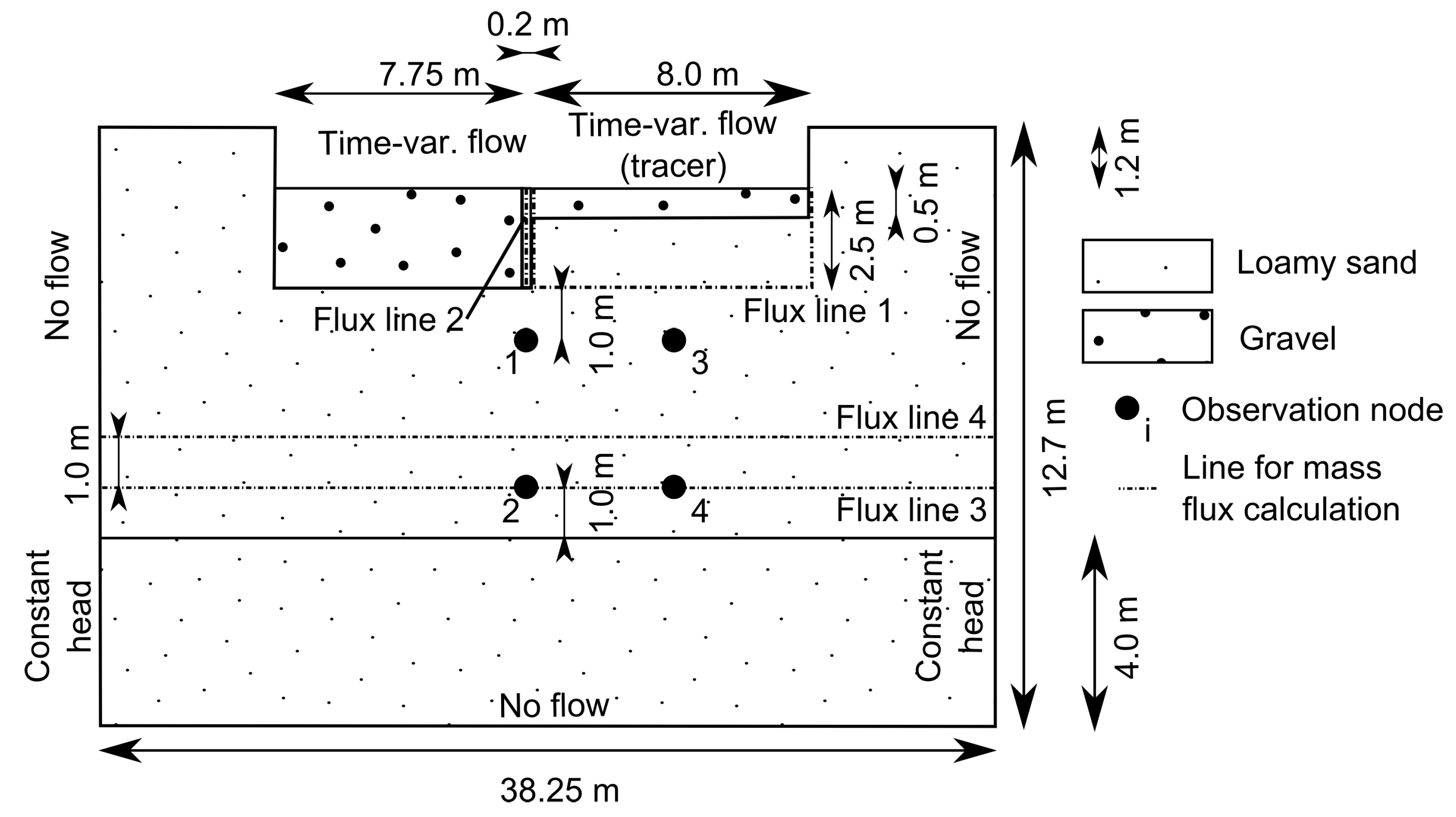
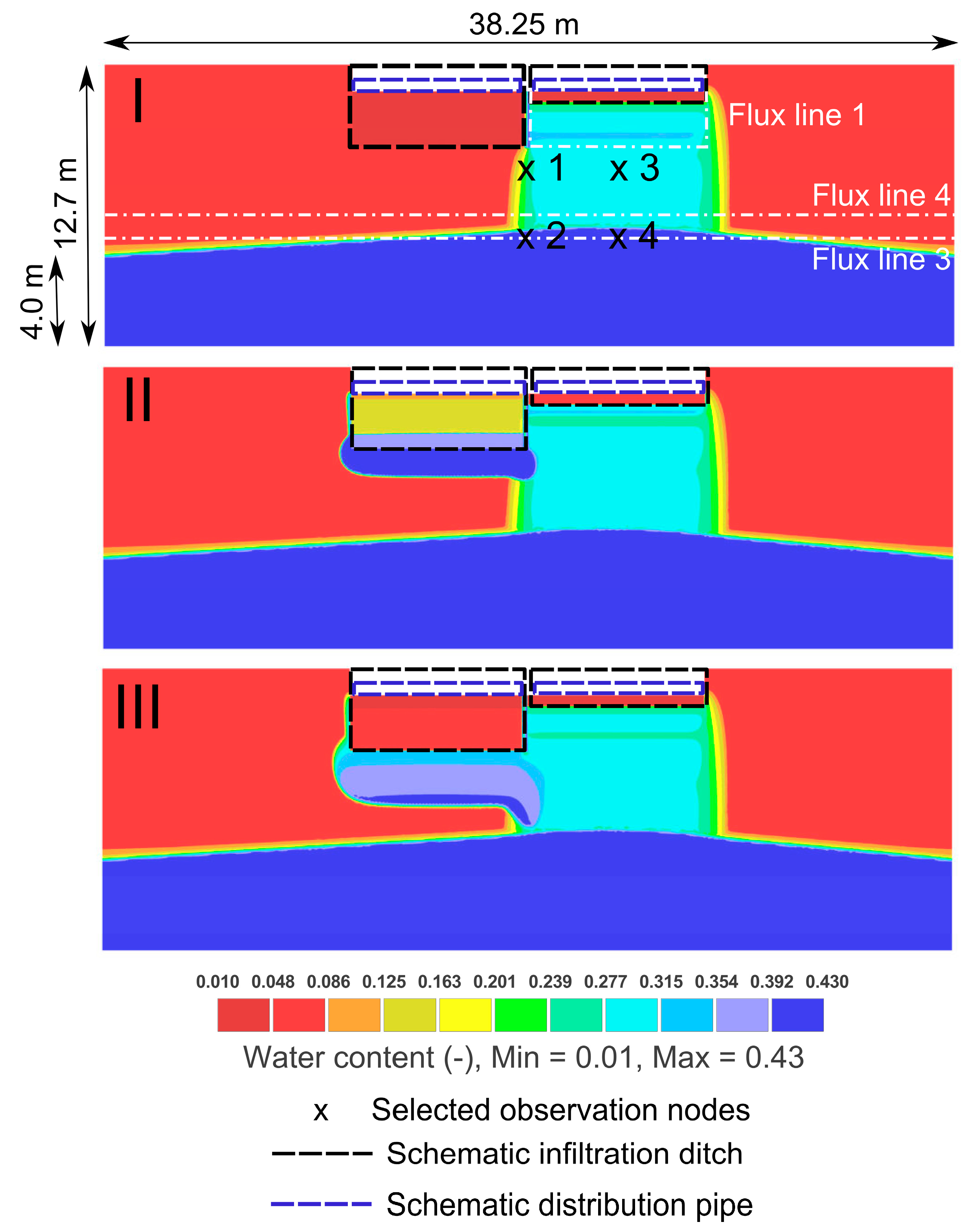

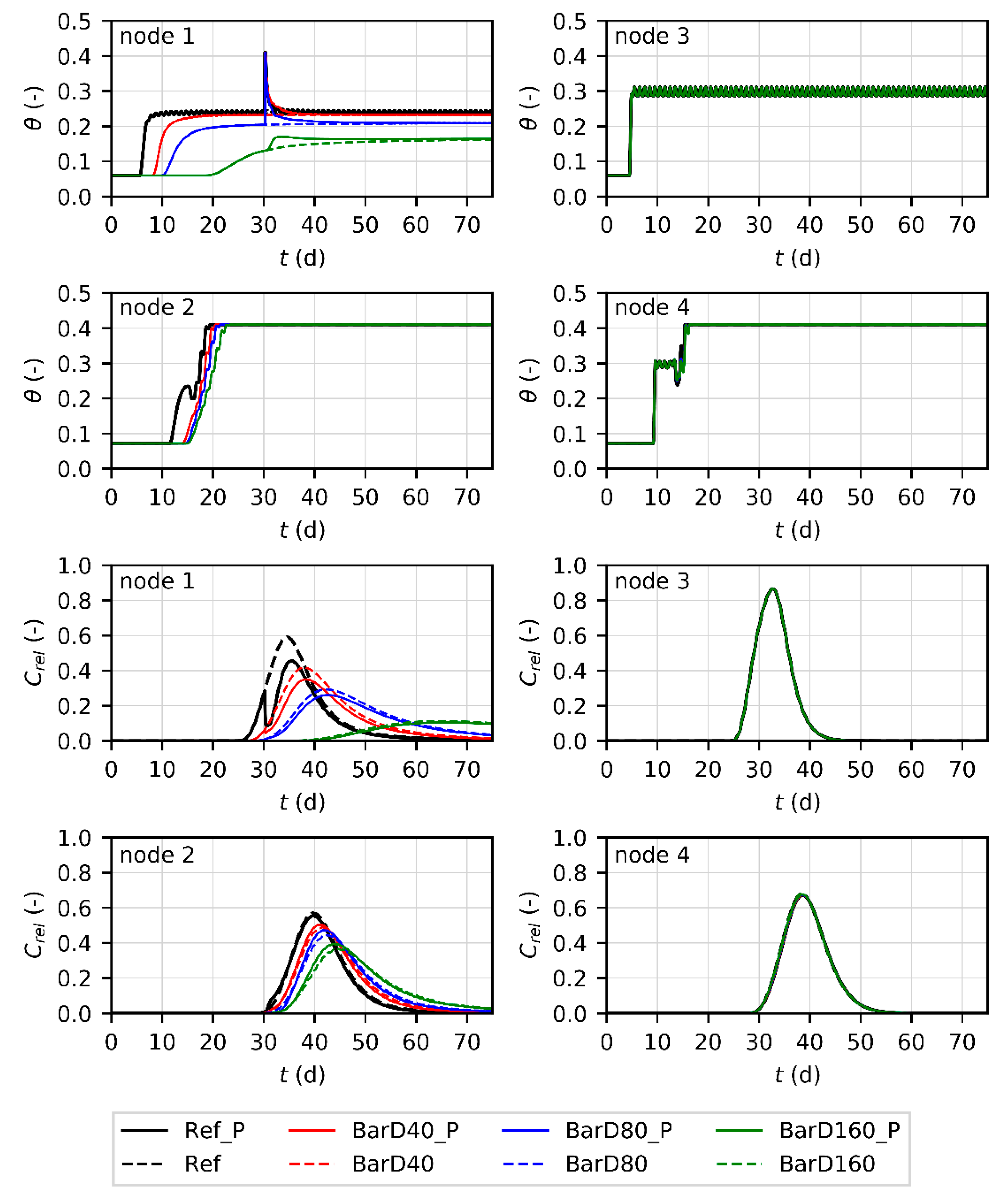
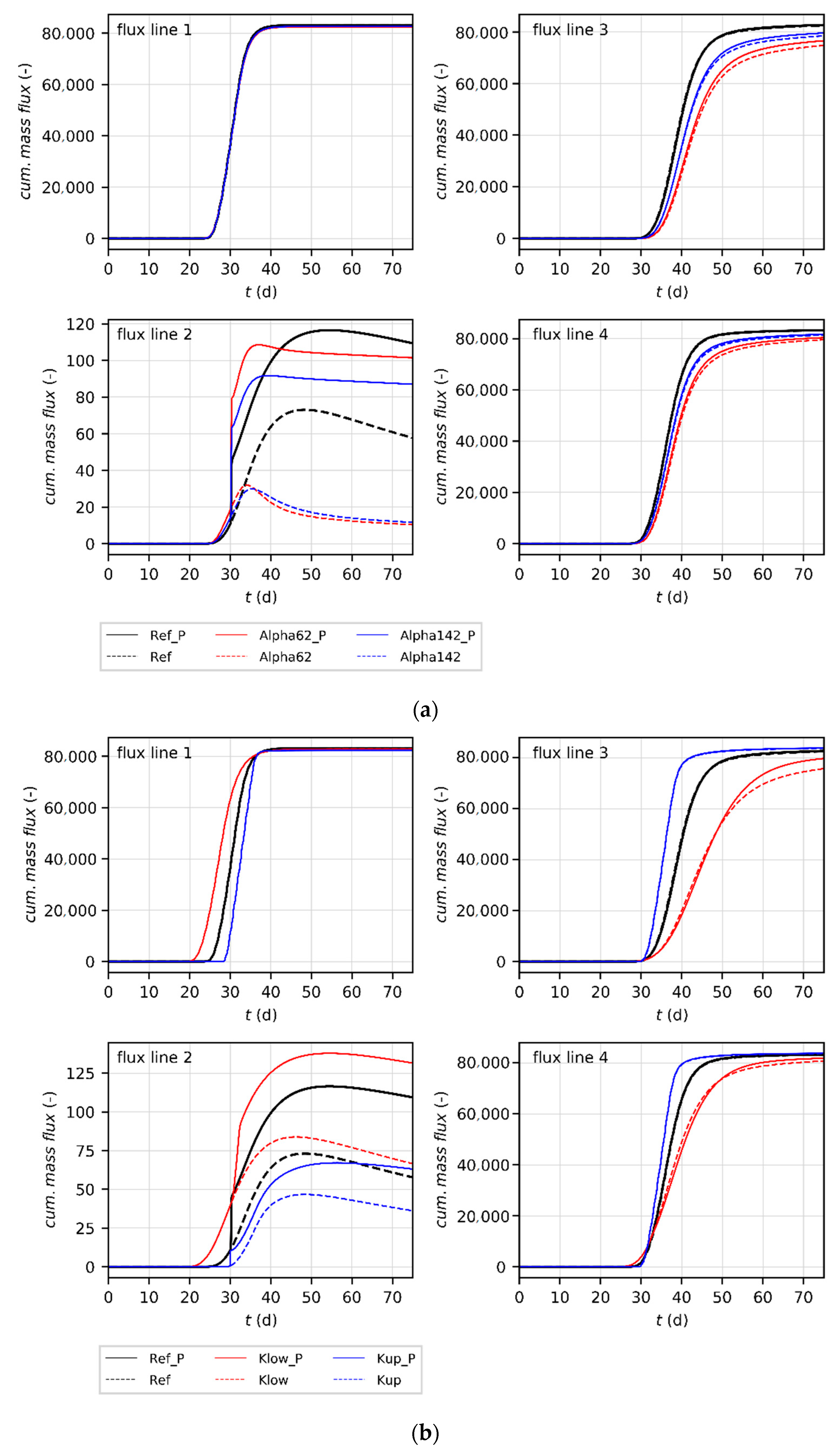
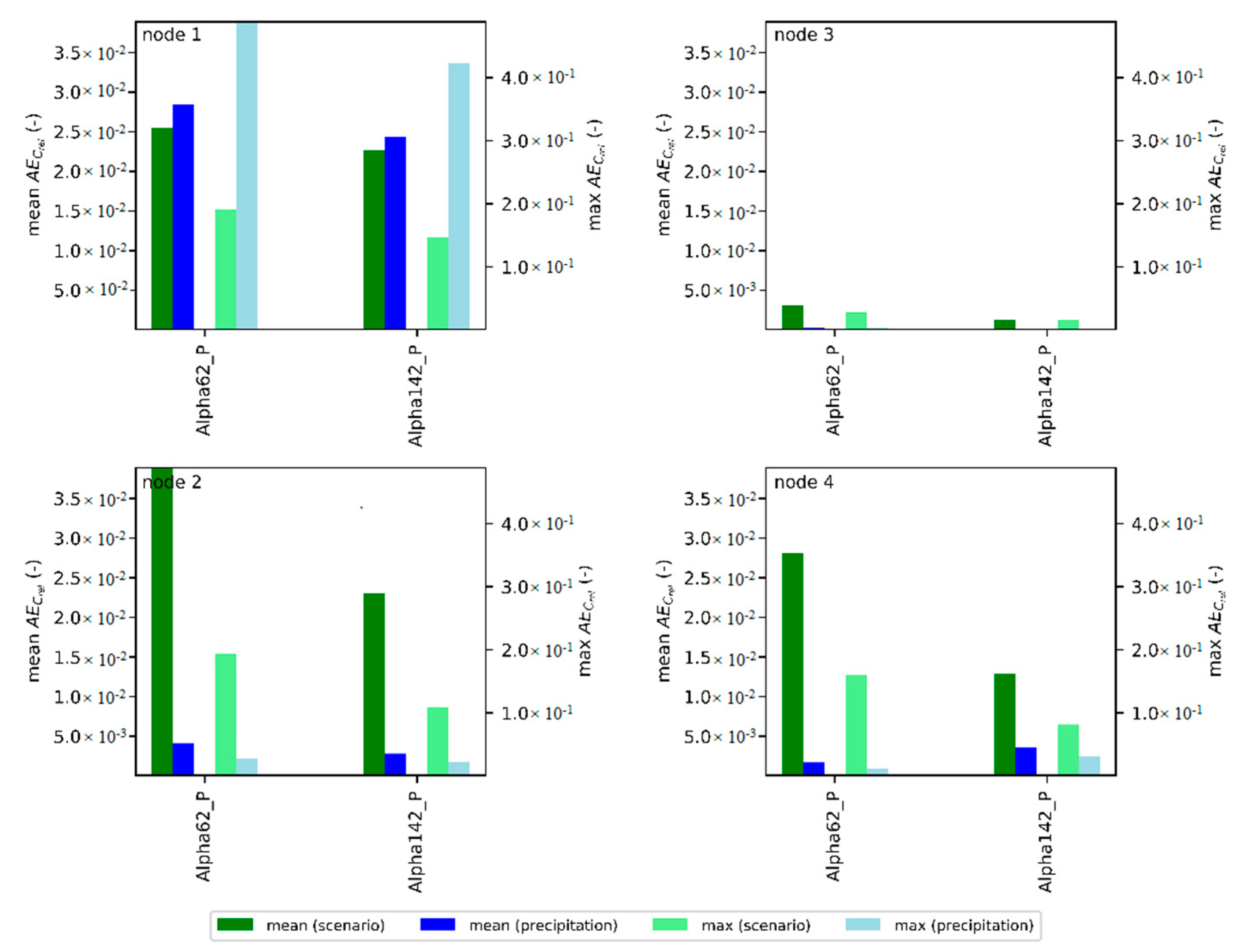
| Duration (min) | 5 | 10 | 15 | 20 | 30 | 45 | 60 | 90 | 120 |
| hN (mm) | 9.7 | 14.7 | 18.1 | 20.7 | 24.5 | 28.5 | 31.5 | 34.7 | 37.2 |
| Duration (min) | 180 | 240 | 360 | 540 | 720 | 1080 | 1440 | 2880 | 4320 |
| hN (mm) | 41.0 | 44.0 | 48.7 | 53.9 | 57.9 | 68.2 | 75.9 | 95.9 | 108.7 |
| Parameter | Value | Reference |
|---|---|---|
| Effective drained area (m²) | 315 | Based on [43] |
| Water-saturated hydraulic conductivity of subsurface material (m·s−1) | 2 × 10−5 | Field infiltration test at Schöneck i.V. in 2017 by Co. M&S Umweltprojekt GmbH [45] |
| Safety factor (-) | 1.2 | [40] |
| Length of infiltration ditch (m) | 7.75 | Iteratively calculated according to Reference [40] |
| Height of infiltration ditch (m) | 2.5 | Assumption, site-specific |
| Porosity of gravel pack (-) | 0.35 | [46] |
| Water-Saturated Hydraulic Conductivity (m·s−1) | Precipitation Water Infiltration | TSE Infiltration | ||||
|---|---|---|---|---|---|---|
| Bottom Area (m2) | Width (m) | Length (m) | Bottom Area (m2) | Width (m) | Length (m) | |
| 5.0 × 10−6 | 24.80 | 2.00 | 12.40 | 5.00 | 0.50 | 10.00 |
| 2.0 × 10−5 | 15.66 | 2.02 | 7.75 | 4.00 | 0.50 | 8.00 |
| 8.0 × 10−4 | 4.90 | 1.00 | 4.90 | 2.00 | 0.50 | 4.00 |
| Scenario | Abbreviation | General Description |
|---|---|---|
| Reference | Ref | General scenario based on Schöneck i.V.; isotropic; homogeneous |
| Higher K value | Kup | Water-saturated hydraulic conductivity of native subsurface material increased from 2 × 10−5 m·s−1 to 8 × 10−4 m·s−1 |
| Lower K value | Klow | Water-saturated hydraulic conductivity of native subsurface material decreased from 2 × 10−5 m·s−1 to 5 × 10−6 m·s−1 |
| Anisotropy | Aniso | Water-saturated horizontal hydraulic conductivity of native subsurface material and gravel increased by a factor of 10 |
| Layered structure | Lay | Integration of layer of reduced permeability (Loam after Hydrus 2D/3D soil catalogue) at depth 2–3 m below precipitation water infiltration ditch |
| Low Alpha value (van Genuchten model) | Alpha142 Alpha62 | Consideration of strong lateral water movement by a small van-Genuchten retention function shape parameter α of 0.0124 cm−1 and 0.0062 cm−1 instead of 0.124 cm−1 for native subsurface material, respectively |
| Higher groundwater table | GWup | Change groundwater table altitude from 5 m to 4 m below precipitation water infiltration ditch |
| Lower groundwater table | GWlow | Change groundwater table altitude from 5 m to 6 m below precipitation water infiltration ditch |
| Local precipitation on TSE ditch | RainTSE | Precipitation water is infiltrated to TSE ditch (i.e., direct precipitation infiltration with respect to TSE ditch area) |
| No hydraulic barrier | NoBar | Removal of vertical hydraulic barrier between both infiltration ditches; gravel assumed |
| Natural hydraulic barrier | BarD40 BarD80 BarD160 | Distance between both infiltration ditches increased to 0.4 m, 0.8 m and 1.6 m, respectively; native subsurface material assumed |
| Stepped infiltration ditches | Step Step2 | Precipitation infiltration is located 1.25 m and 2.5 m deeper as compared to reference case; hydraulic barrier is fixed for 2.5 m from the top of TSE infiltration ditch |
© 2018 by the authors. Licensee MDPI, Basel, Switzerland. This article is an open access article distributed under the terms and conditions of the Creative Commons Attribution (CC BY) license (http://creativecommons.org/licenses/by/4.0/).
Share and Cite
Händel, F.; Engelmann, C.; Klotzsch, S.; Fichtner, T.; Binder, M.; Graeber, P.-W. Evaluation of Decentralized, Closely-Spaced Precipitation Water and Treated Wastewater Infiltration. Water 2018, 10, 1460. https://doi.org/10.3390/w10101460
Händel F, Engelmann C, Klotzsch S, Fichtner T, Binder M, Graeber P-W. Evaluation of Decentralized, Closely-Spaced Precipitation Water and Treated Wastewater Infiltration. Water. 2018; 10(10):1460. https://doi.org/10.3390/w10101460
Chicago/Turabian StyleHändel, Falk, Christian Engelmann, Stephan Klotzsch, Thomas Fichtner, Martin Binder, and Peter-Wolfgang Graeber. 2018. "Evaluation of Decentralized, Closely-Spaced Precipitation Water and Treated Wastewater Infiltration" Water 10, no. 10: 1460. https://doi.org/10.3390/w10101460
APA StyleHändel, F., Engelmann, C., Klotzsch, S., Fichtner, T., Binder, M., & Graeber, P.-W. (2018). Evaluation of Decentralized, Closely-Spaced Precipitation Water and Treated Wastewater Infiltration. Water, 10(10), 1460. https://doi.org/10.3390/w10101460





